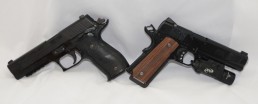Day: December 19, 2013
Zen and the Art of Understanding Firearms
There’s a Zen koan that goes,
“Nan-in, a Japanese master during the Meiji era (1868-1912), received a university professor who came to inquire about Zen.
Nan-in served tea. He poured his visitor's cup full, and then kept on pouring.
The professor watched the overflow until he no longer could restrain himself. ‘It is overfull. No more will go in!’
‘Like this cup,’ Nan-in said, ‘you are full of your own opinions and speculations. How can I show you Zen unless you first empty your cup?’”
That serves as the foundation of any introduction to Zen and Zen Buddhist philosophy. While I won’t be attempting to teach you Zen here, I do recognize the fact that for many people, starting with tabula rasa is the best way to begin any form of education: free of preconceptions and prejudice.
That in mind, let’s begin this partnered meditation on firearms. What I hope to present to you, the reader, is a guide that contains all of the building blocks to understand, operate, and master firearms in general.
So beginning with nothing, the first topic that’d be best to cover is ammunition. What do guns shoot? The correct answer is bullets, but that’s a bit of a misnomer. What you’re most likely to find on sale in stores are technically cartridges. These cartridges are collections that involve a bullet, gunpowder, and a small explosive charge called a primer all wrapped up in a metal casing. These bullets can come in a variety of forms and names, but that’s for a later discussion. Similarly not all gunpowder is created equal. Nor are the primers the same across the multitude of different cartridges. To save time, though, the metal casing only really comes in a handful of different metal types.
The most common of these in modern production is brass. You’ll find brass casings commonly in modern production ammo and it is the de facto standard of modern ammunition. The second most common of these is steel. Steel cases tend to be a sign of Soviet and post-Soviet surplus ammunition, which has its own multitude of quirks that we can discuss later. Other less common and more brand-defined metals are aluminum and a much broader and more vague term called bi-metal which, as the name implies, consists of two different metals. A special note is given to shotgun shells, which are most commonly made with plastics these days, though there are ones made of solid brass.
So what happens to this whole cartridge in the process of actually shooting a gun? Once the trigger is pulled on any given firearm, something strikes the primer, which is a contact explosive. This primer ignites and causes the powder within the metal casing to burn. The burning of the powder creates gas and pressure, which pushes the bullet out of the top of the metal casing and out the barrel.
Simple, isn’t it?

